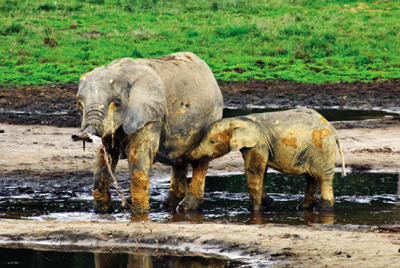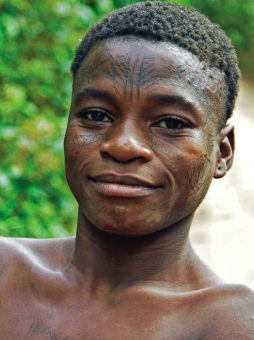Deep in the Central African jungle, lowland gorillas dwell peacefully with inhabitants of the forest. Chimpanzee and leopard, elephant and pygmy wander through one of the largest and least-explored regions of tropical forest in the world. Here, in the Congo Basin, is a place that has long conjured exotic images of cannibalistic tribes, devastating plagues and ferocious creatures, a jungle forever saddled with Conrad’s moniker “heart of darkness.”
Despite recent marketing efforts by the tourism industry, the Congo Basin is still one of the world’s best-kept wildlife secrets. It covers 470 million acres of pristine rain forest in Cameroon, Central African Republic, Congo and Gabon and is home to the world’s largest populations of lowland gorilla, chimpanzee, bonobo and forest elephant.
Lowland gorillas represent nearly 90 percent of the world’s gorilla population, but little is known about them compared to the fame heaped on their better-known cousin, the mountain gorilla. Civil wars and coups have sheltered lowland gorillas from the outside world and kept their habitat relatively intact. However, as Central Africa is developed, human encroachment takes its toll. Deforestation, road construction and slash-and-burn farming have already wiped out almost 90 percent of Central Africa’s rain forests and are threatening the species that long dwelled within.
Conservation groups such as the World Wildlife Foundation are working with local governments to create protected areas and learn more about these great apes. The Dzanga-Sangha Reserve in the Central African Republic and Nouabale-Ndoki National Park in Congo are two such areas, and Dzanga-Sangha now hosts the first group of lowland gorillas habituated for tourism.
It was to see these enigmatic gorillas that I traveled hundreds of miles into the depths of the Congo rain forest. Long fascinated by African wildlife, I was determined to come face to face with a giant silverback.
 I am bound for the rain forest by bush plane. My companions aboard the two-hour flight from Douala, Cameroon, are European tour operators in search of novel expeditions to challenge their well-heeled clients. With gorilla-mania much in vogue, many adventurous travelers have already seen the mountain gorillas and are looking for the next big thing. Little do we know that the Congo Basin will present us with so much more than gorillas.
I am bound for the rain forest by bush plane. My companions aboard the two-hour flight from Douala, Cameroon, are European tour operators in search of novel expeditions to challenge their well-heeled clients. With gorilla-mania much in vogue, many adventurous travelers have already seen the mountain gorillas and are looking for the next big thing. Little do we know that the Congo Basin will present us with so much more than gorillas.
After landing, we weave through the jungle on a narrow red dirt road, our old pickup bumping over washouts and puddles from rainstorms past. We reach a barbed wire fence marking our arrival at the World Wildlife Fund’s Bihokou Camp. Decorative rows of rusted tin cans protect the camp from curious elephants.
Image 2: Family of gorillas in Mbeli Bai, Nouabale-Ndoki National Park, Congo.
Chloe, the head researcher, greets us enthusiastically and radios the BaAka pygmy guides. “We have made contact with the group,” she tells us. “The gorillas are quite far away. We better get going.” Instantly, two tiny men appear from the forest. I fall in step behind the first, David. The forest is cool and dry. A stand of mahogany and other hardwoods has deposited a leafy residue on the trail. We walk downhill with quiet footsteps to the first clearing and enter carefully.
There are two bull elephants only a few hundred yards away. From ground level, especially on foot, elephants look very different. Even at this distance, their sheer mass is intimidating. They lift their heads and we freeze. Statistics run through my head: a full-grown male can weigh up to three tons and can run at 15 miles per hour. Despite their poor eyesight, forest elephants can sense motion and hear the beating of a terrified tourist’s heart for miles.
Chloe whispers a story about one of her researchers who was charged and gored in this very forest six months earlier. The woman lost her glasses while running from the elephant, then stumbled and fell. The elephant pinned her, piercing her hamstring with its tusk, before Chloe managed to whack it on the ear and scare it away. Great, I think.
 The elephants resume drinking and the BaAkas motion for us to move forward. We walk along the forest edge through a swampy area of deep muddy elephant footprints, piles of grassy feces and a small river. No one takes his or her eyes off the elephants.
The elephants resume drinking and the BaAkas motion for us to move forward. We walk along the forest edge through a swampy area of deep muddy elephant footprints, piles of grassy feces and a small river. No one takes his or her eyes off the elephants.
The going gets tougher. A tangle of low branches and ankle-twisting vines snag and tear at our pant legs. The canopy overhead is thick, blocking the sun. Stray shafts of light penetrate, reaching the floor in white stripes that provide stark contrast to the dark greens and browns of the shade.
David darts over and under branches, his 5 feet 4 inches perfectly adapted to this environment. At 5-foot-9, I am constantly bobbing and weaving to avoid the sharp branches and thorny brush.
Unfamiliar scents hang in pockets at each turn of the trail. Some are pleasant—flowers, forest garlic. Others are musky and dank—animal urine and (Chloe confirms) the distinct heavy smell of a silverback male. Sounds are amplified. The crunch of a leaf underfoot crackles sharply. The mind wanders naturally, and uncomfortably, to what is hidden beyond each bend.
David begins making a clucking noise, a sign that we are nearing the group of gorillas. He is letting the silverback know we are approaching. We creep forward to where two other BaAkas are waiting. They point through the underbrush and whisper, “He is there.”
In the shadows, a large figure moves slowly. I catch the gleam of an eye, one that is watching me carefully. I gasp. The intelligence in that look is shocking. The animal’s gaze holds my own and for a split second, I lose my breath. I am eye to eye with a 400-pound silverback lowland gorilla, and he is no more than 25 feet away.
“It’s overwhelming,” Chloe says.
The gorilla, named Makumbo by the researchers, grunts and rises. “Sorry, Makumbo,” Chloe says, diverting her eyes as he scolds and then trudges deeper into the brush. We got too close.
His smell is all around, acrid, burning my nasal passages. His silver hair gleams amid the green foliage, and yet his enormous body blends in. We follow his trail. I would have walked by him again without a second glance if the BaAka were not now pointing him out in the shadows.
Makumbo is a young silverback, approximately 20 years old. His group consists of 13: himself, four females, seven juveniles and one infant. They are spread across the jungle floor around us. The others play, climbing trees to feed, then descending with a cry and occasional chest beat. Makumbo tolerates the frolic with apparent patience.
As he relaxes, we creep closer, hoping to take a photograph through the brush. Raising my lens, I search for a profile, maybe even an eye. He moves and the trudge starts again.
As we claw our way through bush and bramble, insects climb aboard for a ride—and a meal. I have ants in my hair and on my legs. One bites painfully. I squelch a yell and rip it from my arm. It does not come off easily; Central African ants are pit bulls—they bite and they don’t let go.
 The pygmies find Makumbo again, sitting near a large tree, his back to the trunk. He glances over his shoulder at us and scratches his head. He looks away, munches on a piece of grass, then looks at us again. His movements, his gestures are human. His stare gives me a chill and I realize, humbly, that I am allowed here only by his graces and good nature.
The pygmies find Makumbo again, sitting near a large tree, his back to the trunk. He glances over his shoulder at us and scratches his head. He looks away, munches on a piece of grass, then looks at us again. His movements, his gestures are human. His stare gives me a chill and I realize, humbly, that I am allowed here only by his graces and good nature.
Our persistence pays off, though. Makumbo ambles through the forest to a deciduous tree and begins to climb. His massive frame scampers up the small trunk and collapses amid leaves of bright red and yellow. He lies back, facing the sunny sky, reaches out and pulls a branch toward him, munching on the foliage with an occasional peek in our direction.
For half an hour, we watch him dine. Then, he stands up, his entire body visible, and stares down at us for maybe 30 seconds before lumbering down the tree and disappearing into the bush.
On the flight back to Cameroon, I look down at the forest below. The sea of green has varying shades, flowering orange trees and bright green clearings. I now can imagine the animals below, ambling through the darkness, emerging to feed, drink, and bathe. I now know the sight of elephant bulls challenging each other over precious mineral-rich sinkholes, of a mother gorilla cuddling her infant and a herd of buffalo spooking. I can hear the soulful chanting of BaAka pygmies as they move into the forest on a hunt. I know the smell of must, of the damp jungle heat. And as the engines drone, I can hear the jungle speak.
Image 2: A mother forest elephant digs for minerals while her baby nurses.
Image 3: A BaAka pygmy woman with intricate scarification details on her face.
If you go
Trips to the Central African Republic are tricky to say the least. Visas, permits, flights and transportation to the park are complicated and best organized by a tour company experienced in the region. Bushtracks Expeditions, (bushtracks.com), based in Healdsburg, has over 10 years experience and is one of the only U.S.–based companies specializing in bringing visitors to see the lowland gorilla in the Dzanga-Sangha Reserve


